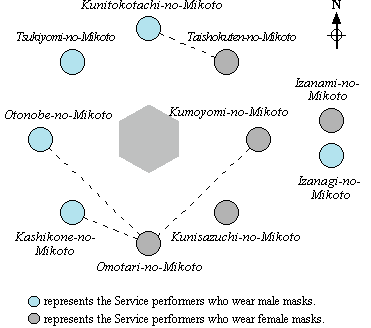The free and unlimited providence of God the Parent is traditionally taught by distinguishing ten aspects of it and giving a sacred name to each so that people may understand and remember them easily.
The sacred names were given to the workings of the instruments that melded into God the Parent's mind and worked in unity at the time of the creation of human beings and the world.
The ten Service performers represent the ten aspects of the complete providence when they perform the Kagura Service around the Jiba.
Each pair of aspects of the complete providence, represented by the two performers facing each other in the Kagura Service, is a mutually complementary pair (see diagram below).
God's providence is described as the divine reason that pervades and governs the human body and the world, as can be seen below.
Kunitokotachi-no-Mikoto: in the human body, the providence of the eyes and fluids; in the world, the providence of water.
Omotari-no-Mikoto: in the human body, the providence of warmth; in the world, the providence of fire.
Kunisazuchi-no-Mikoto: in the human body, the providence of the female organ, of skin and joining; in the world, the providence of joining in general.
Tsukiyomi-no-Mikoto: in the human body, the providence of the male organ, of bones and support; in the world, the providence of support in general.
Kumoyomi-no-Mikoto: in the human body, the providence of eating, drinking, and elimination; in the world, the providence of the rise and fall of moisture.
Kashikone-no-Mikoto: in the human body, the providence of breathing and speaking; in the world, the providence of wind.
Taishokuten-no-Mikoto: the providence of cutting off the ties of the child to its mother at birth, and also in cutting off the breath of life when one passes away for rebirth; in the world, the providence of cutting in general.
Otonobe-no-Mikoto: the providence of pulling out the child from its mother during birth; in the world, the providence of pulling forth in general.
Izanagi-no-Mikoto: the model of man, the seed.
Izanami-no-Mikoto: the model of woman, the seedplot.

* The performers representing Izanagi-no-Mikoto and Izanami-no-Mikoto should be situated at the center, but that is impossible because the Kanrodai stands there.
Instead, they perform east of Kumoyomi-no-Mikoto, standing face to face.
* See the next explanation of the broken lines connecting performers in the diagram.
The six aspects of God's providence during creation
The ten aspects of the complete providence of God the Parent encompass each and every act of divine providence, which pervades the entire world. Among them, there is a set of six aspects that worked in unity when human beings were first conceived. It is referred to as the "six aspects of God's providence during creation." Those six aspects are Kunitokotachi-no-Mikoto, Omotari-no-Mikoto, Kunisazuchi-no-Mikoto, Tsukiyomi-no-Mikoto, Izanagi-no-Mikoto, and Izanami-no-Mikoto. In the story of creation, we read that God established the model of man by putting the orc into the fish and the model of woman by putting the turtle into the serpent. God the Parent, as the Moon, entered the model of man, and God the Parent, as the Sun, entered the model of woman. God taught them the divine providence of creating human beings and then seeded nine hundred million, ninety-nine thousand, nine hundred and ninety-nine children.
On the other hand, there is another set which is sometimes grouped together as the "six aspects of God's providence in the human body." Those six aspects are Kunitokotachi-no-Mikoto, Omotari-no-Mikoto, Kunisazuchi-no-Mikoto, Tsukiyomi-no-Mikoto, Kumoyomi-no-Mikoto, and Kashikone-no-Mikoto. Here, Kumoyomi-no-Mikoto and Kashikone-no-Mikoto replace Izanagi-no-Mikoto and Izanami-no-Mikoto. This set represents the daily blessings of the six aspects in the human body.
In the Kagura Service, each of the Service performers of the four aspects not included in the "six aspects of God's providence during creation" is connected by streamers of white cloth to Tsukihi (Moon-Sun), that is, to either Kunitokotachi-no-Mikoto (Moon) or Omotari-no-Mikoto (Sun), as shown in the diagram.